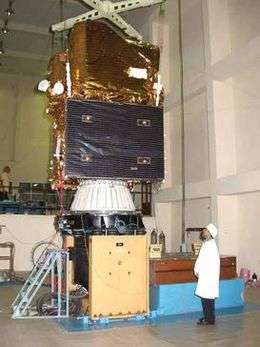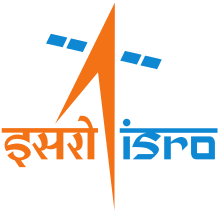Cartosat-1
Cartosat-1 or IRS-P5 is a stereoscopic Earth observation satellite in a sun-synchronous orbit, and the first one of the Cartosat series of satellites. The eleventh satellite of ISRO in IRS series. The satellite was built, launched and maintained by the Indian Space Research Organisation. Weighing around 1560 kg at launch, its applications will mainly be towards cartography in India. It was launched by PSLV-C6, on 5 May 2005 at 04:44:00 UTC from the newly built Second Launch Pad at Sriharikota.[5] Images from the satellite will be available from GeoEye for worldwide distribution. The satellite covers the entire globe in 1867 orbits on a 126-day cycle. Adjacent paths are covered by a separation of eleven days.[6]
 Cartosat-1 satellite | |||||
| Names | IRS-P5 | ||||
|---|---|---|---|---|---|
| Mission type | Earth observation | ||||
| Operator | Indian Space Research Organisation (ISRO) | ||||
| COSPAR ID | 2005-017A | ||||
| SATCAT no. | 28649 | ||||
| Website | https://www.isro.gov.in/Spacecraft/cartosat-1 | ||||
| Mission duration | 5 years (planned), 15 years, 3 months, 4 days (elapsed) | ||||
| Spacecraft properties | |||||
| Bus | IRS-1 [1] | ||||
| Manufacturer | Indian Space Research Organisation (ISRO) | ||||
| Launch mass | 1560 kg [2] | ||||
| Power | 1100 watts [2] | ||||
| Start of mission | |||||
| Launch date | 5 May 2005 at 04:44:00 UTC [3] | ||||
| Rocket | PSLV-C6[4] | ||||
| Launch site | Satish Dhawan, SLP [4] | ||||
| Contractor | Indian Space Research Organisation (ISRO) | ||||
| Orbital parameters | |||||
| Reference system | Geocentric | ||||
| Regime | Sun-synchronous [3] | ||||
| Perigee altitude | 620 km | ||||
| Apogee altitude | 622 km | ||||
| Inclination | 97.9° | ||||
| Period | 97.1 minutes | ||||
| Epoch | 5 May 2005 | ||||
| |||||
Cartosat series | |||||
Cartosat-1 carries two state-of-the-art panchromatic (PAN) cameras that take black and white stereoscopic pictures of the Earth in the visible region of the electromagnetic spectrum. The swath covered by these high resolution PAN cameras is 30 km and their spatial resolution is 2.5 metres.
History
Department of Space, Government of India, has launched a series of satellites for Earth's resource management and monitoring. These satellites have been very successful in providing data in various scales ranging from 1:1 Million to 1:12,500 scale.[6] Each of the Indian Remote Sensing satellite missions ensured data continuity while introducing improvements in the spatial, spectral and radiometric resolutions. Considering increase demand for large scale and topographic mapping data DOS launched the Cartosat-1 in 2005. Cartosat-1 is dedicated to stereo viewing for large scale mapping and terrain modelling.
Specifications
Payload
The Cartosat-1 satellite has two panchromatic cameras with 2.5 m spatial resolution, to acquire two images simultaneously, one forward (PAN FORE) looking at +26° and one aft (PAN AFT) of the satellite at -5° for near instantaneous stereo data. The time difference between the acquisitions of the same scene by the two cameras is about 52 seconds.[6] The spacecraft body is steerable to compensate the Earth rotation effect and to force both fore and aft cameras to look at the same ground strip when operated in stereo mode. The cameras are mounted on the satellite in such a way that near simultaneous imaging of the same area from two different angles is possible. This facilitates the generation of accurate three-dimensional maps. The cameras are steerable across the direction of the satellite's movement to facilitate the imaging of an area more frequently.
Communications
The images taken by Cartosat-1 cameras are compressed, encrypted, formatted and transmitted to the ground stations. The images are reconstructed from the data received at the ground stations. The National Remote Sensing Centre is responsible for acquisition, processing of data relayed by the Cartosat-1. A spherical Phased Array Antenna with steerable beam is used to transmit the data to the required ground station. A solid state recorder with 120 Gb capacity to store about 9 minutes of payload data is available for global operation of the payloads. The stored images can be transmitted when the satellite comes within the visibility zone of a ground station.
Optics and detectors
Each Panchromatic camera consists of three 3 mirror off-axis all reflective telescope with primary, secondary and tertiary mirrors. These mirrors are made from special zerodur glass blanks and are light weighted to about 60%. These mirrors are polished to an accuracy of l/80 and are coated with enhanced AlO2 coating. In order to meet the high resolution and the swath requirement a 12K, 7 µm linear array CCD is used as a detector.[7]
Imaging capabilities
Spatial resolution
- 2.5 m panchromatic band (0.5-0.85 µm)[7]
Temporal resolution
The revisit rate for Cartosat-1 is five days.[7]
Radiometric resolution
The sensor collects data with a 10-bit sensitivity.[7]
Swath
30 km (PAN-F) and 25 km (PAN-A)[7]
See also
References
- Krebs, Gunter. "IRS P5 (Cartosat 1)". Gunter's Space Page. Retrieved 19 June 2017.
- "Cartosat-1". Indian Space Research Agency. 5 May 2005. Retrieved 19 June 2017.
- "Cartosat-1: Trajectory 2005-017A". nssdc.gsfc.nasa.gov. NASA. 17 April 2020. Retrieved 14 May 2020.

- "PSLV C6/IRS-P5/HAMSAT Mission Brochure" (PDF). Indian Space Research Organisation. Retrieved 19 June 2017.
- "PSLV-C6 launched from Sriharikota". The Economic Times. India. 5 May 2005. Retrieved 18 September 2012.
- "NRSC: Cartosat-1". Archived from the original on 29 August 2015. Retrieved 18 September 2012.
- Indian Remote Sensing Satellite Cartosat-1: Technical features and data products

